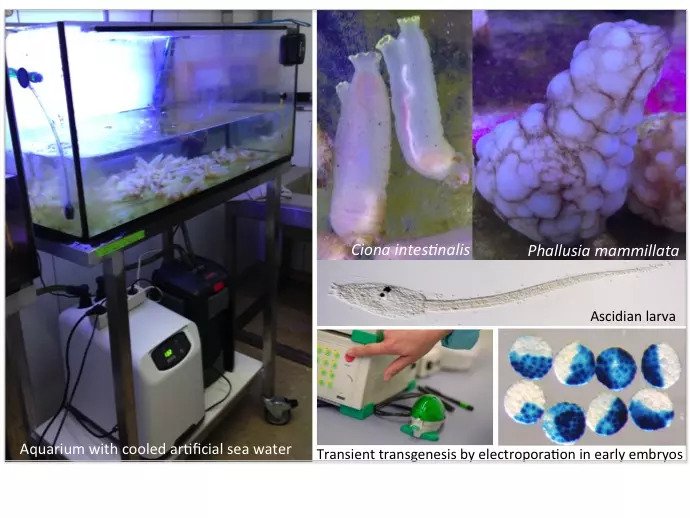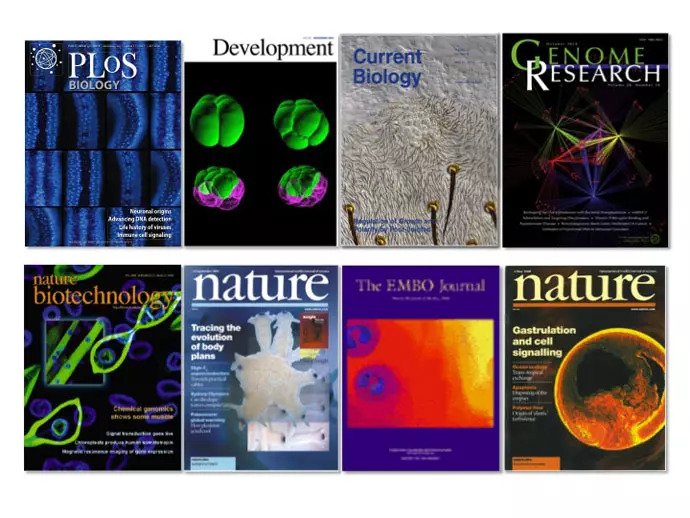Ute Rothbächer
Associate Professor

Address:
Department of Zoology
University of Innsbruck
Technikerstr. 25
6020 Innsbruck
Austria
Room: 7/09
Current Research
How the dynamic developmental program is inscribed in the genome and inherited to subsequent generations remains poorly understood. Efficient functional readout, notably at DNA level in vivo is often complicated by the complexity of regulatory interactions and the complexity of genomes, particularly in vertebrates.
To unravel fundamental genetic mechanisms that control cell fate choice in vivo, we study embryonic development in a simple marine invertebrate, the ascidian Ciona intestinalis, belonging to the vertebrate sister group, the tunicates. Larval equivalent stages of ascidians and vertebrates have resembling structures such as a central notochord (embryonic structure forming the vertebral colomn in vertebrates), flanking muscles, a dorsal neural tube and notably a head with sensory organs that may be related to the greatly expanded sensory epithelia in vertebrates. The latter ‘new head’ of vertebrates likely evolved towards their successful predatory lifestyle. Whats more, ascidian embryos develop with a fixed cellular lineage based on few and large cells allowing cellular resolution of cell fate identity. The fully sequenced genome, since compact and unduplicated, gives acces to regulatory DNA segments, isolated for reporter gene essays in vivo. Such DNA constructs, when electroporated in fertilised eggs, produce transiently transgenic embryos and allow rapid gene functional and gene regulatory analyses, in precisely identifyable tissue precursors, from earliest embryonic stages in vivo.
Our research aims on deciphering embryonic gene network signatures in ascidians are:
1) the mechanisms and dynamics for gene regulatory switches affecting the pluripotent ectoderm in vivo giving rise to neural precursors. These form head sensory organs including the sensory vesicle (brain, light, gravity) and the papillae (sensory adhesive organ, for settlement and metamorphosis). We focus on novel combinatorial codes and repressive activities of nuclear effectors for major signaling pathways, notably Wnt and FGF/MEK signaling influencing the cell fate choice of neural precursors.
2) the genetic and molecular basis for ascidian bioadhesion (via their larval sensory adhesive organ, the papillae) motivated by the search for novel biomimetic reagents.
JOVE Movie: Embryo Microinjection and Electroporation in the Chordate Ciona intestinalis
newsroom 2022 (in German): Wichtiger Ursprung unserer Sinne identifiziert
newsroom 2024 (in German): Molekulare Einblicke in die Evolutionsgeschichte

Curriculum vitae
| _ | _ |
|---|---|
| 1988 | MSc (Diploma), Zoology and Immunology, TU and LMU Munich, Germany |
| 1994 | PhD (Dr. rer.nat.), Inst. for Immunology, LMUniversity Munich, Germany |
| 1994-1998 | Postdoc Boehringer Ingelheim Fonds, UC Irvine and Caltech, USA |
| 1999-2012 | CNRS, Inst. for Developmental Biology Marseille (IBDM), France |
| 2008 | Habilitation in Developmental Biology, Univ. Aix-Marseille, France |
| 2012-2015 | Assistant Professor, Institute of Zoology, University Innsbruck, Austria |
| Since 2015 | Associate Professor, Institute of Zoology, University Innsbruck, Austria |

Publikationen 2024
Beiträge in Büchern / Zeitschriften
Zeitschriftenaufsatz (Originalarbeit)
- Johnson, C. J.; Razy-Krajka, F.; Zeng, F.; Piekarz, K. M.; Biliya, S.; Rothbächer, U.; Stolfi, A (2024): Specification of distinct cell types in a sensory-adhesive organ important for metamorphosis in tunicate larvae.
In: PLoS Biology 22/3, Nr. e3002555. (DOI) (Weblink) - Pennati, A.; Jakobi, M.; Zeng, F.; Ciampa, L.; Rothbächer, U. (2024): Optimizing CRISPR/Cas9 approaches in the polymorphic tunicate Ciona intestinalis.
In: Developmental Biology 510, S. 31 - 39. (DOI) (Weblink)
Sonstige Publikationen
elektronische Publikation (Preprint)
- Drago, L.; Pennati, A.; Rothbächer, U.; Ashita, R.; Hashimoto, S.; Saito, R.; Fujiwara, S.; Ballarin, L. (2024): Stress granule-related genes during embryogenesis of an invertebrate chordate. (Weblink)
Medienbeiträge
Beitrag in Zeitung
- Rothbächer, Ute: Molekulare Einblicke in die Evolutionsgeschichte.
In: Newsroom - www.uibk.ac.at vom 15.04.2024. (Weblink)
Publikationen 2023
Beiträge in Büchern / Zeitschriften
Zeitschriftenbeitrag (Proceedings Paper)
- Rothbächer, U (2023): Ascidian gene regulation and bioadhesion.
In: Genesis 61/6, No. e23572. (DOI) (Weblink)
Sonstige Publikationen
elektronische Publikation (Preprint)
- Johnson, Christopher; Razy-Krajka, Florian; Zeng, Fan; Piekarz, Katarzyna; Biliya, Shweta; Rothbächer, Ute; Stolfi, Alberto (2023): Specification of distinct cell types in a sensory-adhesive organ for metamorphosis in the ciona larva.". (DOI) (Weblink)
Publikationen 2022
Beiträge in Büchern / Zeitschriften
Zeitschriftenaufsatz (Originalarbeit)
- Papadogiannis, V.; Pennati, A.; Parker, H.J.; Rothbächer, U.; Patthey, C.; Bronner, M.E.; Shimeld, S.M. (2022): Hmx gene conservation identifies the origin of vertebrate cranial ganglia.
In: Nature 605/7911, S. 701 - 705. (DOI) (Weblink)
Sammelbandaufsatz (Originalarbeit)
- Zeng, F.; Peronato, A.; Ballarin, L.; Rothbächer, U. (2022): Sweet Tunicate Blood Cells: A Glycan Profiling of Haemocytes in Three Ascidian Species.
In: Ballarin, L.; Rinkevich, B.; Hobmayer, B.: Advances in Aquatic Invertebrate Stem Cell Research: From Basic Research to Innovative Applications. Basel: MDPI AG., ISBN 978-3-0365-1636-3, S. 351 - 379. (DOI) (Weblink)
Medienbeiträge
Beitrag in Publikumszeitschrift
- Rothbächer, U.; Pennati, A.: Wichtiger genetischer Ursprung unserer Sinne identifiziert (Interview).
In: wissenswert - Magazin der Universität Innsbruck vom 18.05.2022. (Weblink)
Publikationen 2021
Beiträge in Büchern / Zeitschriften
Zeitschriftenaufsatz (Originalarbeit)
- Davey, P.A.; Power, A.M.; Santos, R.; Bertemes, P.; Ladurner, P.; Palmowski, P.; Clarke, J.; Flammang, P.; Lengerer, B.; Hennebert, E.; Rothbächer, U.; Pjeta, R.; Wunderer, J.; Zurovec, M.; Aldred, N. (2021): Omics-based molecular analyses of adhesion by aquatic invertebrates.
In: Biological Reviews 96/3, S. 1051 - 1075. (DOI) (Weblink)
Publikationen 2020
Beiträge in Büchern / Zeitschriften
Zeitschriftenaufsatz (Originalarbeit)
- Imai, K.; Kobayashi, K.; Kari, W.; Rothbächer, U.; Ookubo, N.; Oda-Ishii, I.; Satou, Y. (2020): Gata is ubiquitously required for the earliest zygotic gene transcription in the ascidian embryo.
In: Developmental Biology 458/2, S. 215 - 227. (DOI) (Weblink) - Peronato, A.; Drago, L.; Rothbächer, U.; Macor, P.; Ballarin, L.; Nicola Franchi, N. (2020): Complement system and phagocytosis in a colonial protochordate.
In: Developmental & Comparative Immunology 103, No. 103530. (DOI) (Weblink)
Publikationen 2019
Beiträge in Büchern / Zeitschriften
Zeitschriftenaufsatz (Originalarbeit)
- Zeng, F.; Wunderer, J.; Salvenmoser, W.; Ederth, T.; Rothbächer, U. (2019): Identifying adhesive components in a model tunicate.
In: Philosophical Transactions of The Royal Society B - Biological Sciences 374/1784, No. 20190197. (DOI) (Weblink) - Zeng, F.; Wunderer, J.; Salvenmoser, W.; Hess, M.W.; Ladurner, P.; Rothbächer, U. (2019): Papillae revisited and the nature of the adhesive secreting collocytes.
In: Developmental Biology 448/2, S. 183 - 198. (DOI) (Weblink)
Publikationen 2017
Sonstige Publikationen
elektronische Publikation (Preprint)
- Guéroult-Bellone, M.; Nitta, K.R.; Kari, W.; Jacox, E.; Beulé Dauzat, R.; Vincentelli, R.; Diarra, C.; Rothbächer, U.; Dantec, C.; Cambillau, C.; et al. (2017): Spacer sequences separating transcription factor binding motifs set enhancer quality and strength. (DOI) (Weblink)
Publikationen 2016
Beiträge in Büchern / Zeitschriften
Zeitschriftenaufsatz (Originalarbeit)
- Kari, W.; Zeng, F.; Zitzelsberger, L.; Will, J.P.; Rothbächer, U. (2016): Embryo Microinjection and Electroporation in the Chordate Ciona intestinalis.
In: Jove-Journal of Visualized Experiments 116, Nr. e54313. (Volltext) (DOI) (Weblink) - Oda-Ishii, I.; Kubo, A.; Kari, W.; Suzuki, N.; Rothbächer, U.; Satou, Y. (2016): A Maternal System Initiating the Zygotic Developmental Program through Combinatorial Repression in the Ascidian Embryo.
In: PLoS Genetics 12/5, Nr. e1006045. (DOI) (Weblink)
Publikationen 2015
Beiträge in Büchern / Zeitschriften
Zeitschriftenaufsatz (Originalarbeit)
- Gilchrist, M.J.; Sobral, D.; Khoueiry, P.; Daian, F.; Laporte, B.; Patrushev, I.; Matsumoto, J.; Dewar, K.; Hastings, K.E.M.; Satou, Y.; Lemaire, P.; Rothbächer, U. (2015): A pipeline for the systematic identification of non-redundant full-ORF cDNAs for polymorphic and evolutionary divergent genomes: Application to the ascidian Ciona intestinalis.
In: Developmental Biology 404/2, S. 149 - 163. (DOI) (Weblink) - Murgan, S.; Kari, W.; Rothbächer, U.; Iché-Torres, M.; Mélénec, P.; Hobert, O.; Bertrand, V. (2015): Atypical transcriptional activation by TCF via a Zic transcription factor in C. elegans neuronal precursors.
In: Developmental Cell 33/6, S. 737 - 745. (DOI) (Weblink) - Pennati, R.; Rothbächer, U. (2015): Bioadhesion in ascidians: a developmental and functional genomics perspective.
In: Interface Focus 5/1, No. 20140061. (Volltext) (DOI) (Weblink)
Medienbeiträge
Beitrag in Publikumszeitschrift
- Rothbächer, U.: Werkzeugkasten der Entwicklungsbiologie (Interview).
In: wissenswert - Magazin der Universität Innsbruck vom 17.02.2015. (Weblink)
Publikationen 2013
Sonstige Publikationen
elektronische Publikation, transferorientierte
- Rothbächer, U. (2013): Bericht zum „Phallusia Jamboree“, Montpellier, France; 28th-30th May 2013. (Weblink)
- Rothbächer, U. (2013): Bericht zum „4ème Seminaire EFOR“ (Network for Functional Studies in Model Organisms), 13.-14. Februar 2013, Paris, France. (Weblink)
Publikationen 2012
Beiträge in Büchern / Zeitschriften
Zeitschriftenaufsatz (Originalarbeit)
- Pasini, A.; Manenti, R.; Rothbächer, U.; Lemaire, P. (2012): Antagonizing retinoic acid and FGF/MAPK pathways control posterior body patterning in the invertebrate chordate Ciona intestinalis.
In: PLoS One 7/9, S. e46193. (DOI)
Publications before 2012
- Tassy, O., Dauga, D., Daian, F., Sobral, D., Robin, F., Khoueiry, P., Salgado, D., Fox, V., Caillol, D., Schiappa, R., Laporte, B., Rios, A., Luxardi, G., Kusakabe, T., Joly, J.S., Darras, S., Christiaen, L., Contensin, M., Auger, H., Lamy, C., Hudson, C., Rothbächer, U., Gilchrist, M.J., Makabe, K.W., Hotta, K., Fujiwara, S., Satoh, N., Satou, Y.and Lemaire, P. (2010). The ANISEED database: digital representation, formalization, and elucidation of a chordate developmental program. Genome Res 20, 1459-1468. doi:10.1101/gr.108175.110 (Web link)
- Khoueiry, P., Rothbächer, U., Ohtsuka, Y., Daian, F., Frangulian, E., Roure, A., Dubchak, I.and Lemaire, P. (2010). A cis-regulatory signature in ascidians and flies, independent of transcription factor binding sites. Curr Biol 20, 792-802. doi:10.1016/j.cub.2010.03.063
- Roure, A., Rothbächer, U., Robin, F., Kalmar, E., Ferone, G., Lamy, C., Missero, C., Mueller, F.and Lemaire, P. (2007). A multicassette Gateway vector set for high throughput and comparative analyses in ciona and vertebrate embryos. PLoS One 2, e916. doi:10.1371/journal.pone.0000916
- Rothbächer, U. , Bertrand, V., Lamy, C.and Lemaire, P. (2007). A combinatorial code of maternal GATA, Ets and beta-catenin-TCF transcription factors specifies and patterns the early ascidian ectoderm. Development 134, 4023-4032. doi:10.1242/dev.010850
- Pasini, A., Amiel, A., Rothbächer, U., Roure, A., Lemaire, P.and Darras, S. (2006). Formation of the ascidian epidermal sensory neurons: insights into the origin of the chordate peripheral nervous system. PLoS Biol 4, e225. doi:10.1371/journal.pbio.0040225
- Lamy, C., Rothbächer, U., Caillol, D.and Lemaire, P. (2006). Ci-FoxA-a is the earliest zygotic determinant of the ascidian anterior ectoderm and directly activates Ci-sFRP1/5. Development 133, 2835-2844. doi:10.1242/dev.02448
- Rothbächer, U. and Lemaire, P. (2002). Creme de la Kremen of Wnt signalling inhibition. Nat Cell Biol 4, E172-173. doi:10.1038/ncb0702-e172
- Wallingford, J.B., Rowning, B.A., Vogeli, K.M., Rothbächer, U., Fraser, S.E.and Harland, R.M. (2000). Dishevelled controls cell polarity during Xenopus gastrulation. Nature 405, 81-85. doi:10.1038/35011077
- Rothbächer, U. , Laurent, M.N., Deardorff, M.A., Klein, P.S., Cho, K.W.and Fraser, S.E. (2000). Dishevelled phosphorylation, subcellular localization and multimerization regulate its role in early embryogenesis. EMBO J 19, 1010-1022. doi:10.1093/emboj/19.5.1010
- Louie, A.Y., Huber, M.M., Ahrens, E.T., Rothbächer, U., Moats, R., Jacobs, R.E., Fraser, S.E.and Meade, T.J. (2000). In vivo visualization of gene expression using magnetic resonance imaging. Nat Biotechnol 18, 321-325. doi:10.1038/73780
- Hobmayer, B., Rentzsch, F., Kuhn, K., Happel, C.M., von Laue, C.C., Snyder, P., Rothbächer, U.and Holstein, T.W. (2000). WNT signalling molecules act in axis formation in the diploblastic metazoan Hydra. Nature 407, 186-189. doi:10.1038/35025063
- Bauer, A., Chauvet, S., Huber, O., Usseglio, F., Rothbächer, U., Aragnol, D., Kemler, R.and Pradel, J. (2000). Pontin52 and reptin52 function as antagonistic regulators of beta-catenin signalling activity. EMBO J 19, 6121-6130. doi:10.1093/emboj/19.22.6121
- Ahrens, E.T., Rothbächer, U., Jacobs, R.E.and Fraser, S.E. (1998). A model for MRI contrast enhancement using T1 agents. Proc Natl Acad Sci U S A 95, 8443-8448.
- Laurent, M.N., Blitz, I.L., Hashimoto, C., Rothbächer, U.and Cho, K.W. (1997). The Xenopus homeobox gene twin mediates Wnt induction of goosecoid in establishment of Spemann's organizer. Development 124, 4905-4916.
- Johnson, J.P., Rummel, M.M., Rothbächer, U.and Sers, C. (1996). MUC18: A cell adhesion molecule with a potential role in tumor growth and tumor cell dissemination. Curr Top Microbiol Immunol 213 ( Pt 1), 95-105.
- Watabe, T., Kim, S., Candia, A., Rothbächer, U., Hashimoto, C., Inoue, K.and Cho, K.W. (1995). Molecular mechanisms of Spemann's organizer formation: conserved growth factor synergy between Xenopus and mouse. Genes Dev 9, 3038-3050.
- Rothbächer, U. , Laurent, M.N., Blitz, I.L., Watabe, T., Marsh, J.L.and Cho, K.W. (1995). Functional conservation of the Wnt signaling pathway revealed by ectopic expression of Drosophila dishevelled in Xenopus. Dev Biol 170, 717-721. doi:10.1006/dbio.1995.1249
- Sers, C., Kirsch, K., Rothbächer, U., Riethmuller, G.and Johnson, J.P. (1993). Genomic organization of the melanoma-associated glycoprotein MUC18: implications for the evolution of the immunoglobulin domains. Proc Natl Acad Sci U S A 90, 8514-8518.
- Johnson, J.P., Rothbächer, U.and Sers, C. (1993). The progression associated antigen MUC18: a unique member of the immunoglobulin supergene family. Melanoma Res 3, 337-340.
- Lehmann, J.M., Holzmann, B., Rothbächer, U., Riethmuller, G.and Johnson, J.P. (1989). [Step-wise expression of melanoma-associated antigens in tumor progression]. Onkologie 12, 273-276.
- Johnson, J.P., Lehmann, J.M., Stade, B.G., Rothbächer, U., Sers, C.and Riethmuller, G. (1989). Functional aspects of three molecules associated with metastasis development in human malignant melanoma. Invasion Metastasis 9, 338-350.


